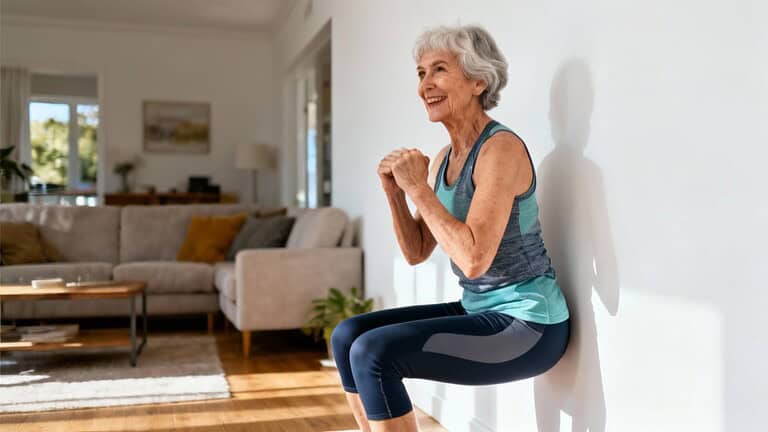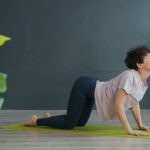I used to think a brisk walk every day was enough. Maybe throw in some light stretching, a few trips up the stairs, and I’d be set for life. But then something changed.
I remember one morning I stood up from the couch and my knees cracked like old wood. My legs felt shaky, like they no longer trusted me. I brushed it off until it started happening every day.
And I’m not alone. Over 60% of adults over 50 experience joint pain, poor balance, or unexplained muscle weakness—not because they’re lazy, but because they’ve been moving the wrong way. But here’s the part no one tells you: it’s not about moving more; it’s about moving smarter.
Today, I’m sharing five simple equipment-free exercises that can retrain your body not in months, but in just days. These moves are gentle on joints yet powerfully effective at rebuilding the strength and stability that aging quietly takes away.
Exercise 1: The Wall Sit—Stand Superpower
Let me ask you something simple: how easily can you get up from a low chair without using your hands? If that question made you pause, you’re not alone. The ability to go from sitting to standing is one of the strongest predictors of independence as we age.
That’s where the wall sit comes in. It looks simple, but when done right, it rebuilds the exact muscles that support you every time you stand, sit, climb stairs, or even catch yourself from a stumble.
How to do it:
- Stand with your back flat against a wall, feet shoulder-width apart, about two feet away from the wall
- Slowly slide down the wall as if you’re sitting on an invisible chair
- Your thighs should be parallel to the floor, knees stacked over ankles
- Can’t go that low yet? No problem. Start higher and work your way down over time
- Hold for 20 to 30 seconds, then slowly come back up
- Rest and repeat three times
Unlike squats or lunges, the wall sit is isometric, meaning your muscles are under tension without joint movement. That means less pressure on your knees but the same strength-building benefits. You’re activating your quads, glutes, hamstrings, and core all at once.
Exercise 2: Marching Hold—Balance Starts in the Hips
Here’s a quick test: stand up tall and lift one foot off the ground. How long can you hold it without grabbing something? If it’s less than 10 seconds, don’t worry; it’s not just you.
After age 50, our hip stabilizers and ankle control begin to fade quietly. That’s why this next move, the marching hold, is deceptively powerful.
How to do it:
- Stand near a wall or sturdy chair for balance
- Shift your weight onto one leg
- Slowly lift the other knee to hip height or as high as feels safe, and hold for five seconds
- Lower it slowly
- Repeat on the other side
- Do 10 reps per leg, alternating
It seems basic, but the magic is in the stillness. You’re waking up the deep stabilizer muscles in your hips, thighs, core, and ankles—muscles that, once they go offline, quietly raise your risk of falling.
Exercise 3: Wall Push Hold—Strength Without Strain
I remember the first time I noticed my upper body was getting weaker. It wasn’t at the gym; it was in the kitchen, struggling to lift a pot that used to feel light, or reaching up to grab a mug from the cabinet and feeling that annoying pinch in my shoulder.
That’s why I love the wall push hold. It delivers surprising upper body strength with zero joint impact.
How to do it:
- Stand facing a wall, feet hip-width apart, about an arm’s length away
- Stretch your arms forward so your palms are flat on the wall at shoulder height
- Press into the wall as if you’re trying to push it over, but don’t move
- Keep your spine neutral, core tight, shoulders down and back
- Hold for 15 to 20 seconds, then relax
- Repeat three times
This is called an isometric contraction. Your muscles fire up without any actual movement. That means you’re building strength while being gentle on your elbows, shoulders, and wrists.
Exercise 4: Glute Bridge Hold—The Underrated Fix for Back Pain and Power Loss
There was a time I couldn’t get up off the floor without making a sound—a grunt here, a groan there, and let’s not talk about trying to tie my shoes. I thought it was just getting older.
But what I didn’t realize was that my posterior chain—the powerful line of muscles running from my glutes to hamstrings to lower back—had quietly weakened.
Enter the glute bridge hold: a simple floor exercise that can flip that script in just minutes a day.
How to do it:
- Lie on your back with your knees bent, feet flat on the floor, arms resting by your sides
- Slowly lift your hips off the ground, squeezing your glutes until your body forms a straight line from shoulders to knees
- Hold this position for 20 to 30 seconds, then lower gently
- Repeat three times
This move trains your glutes, hamstrings, and lower back to work together the way they’re supposed to. When that chain is strong, you move more efficiently, protect your spine, and reduce strain on your knees and hips.
Exercise 5: Cross-Body Crunch Lying Version—Coordination Without the Wobble
Let’s be real: not everyone over 50 feels steady enough to stand on one leg and twist at the same time. And that’s okay. Balance isn’t built in chaos; it’s built in control.
That’s why this final move, the cross-body crunch, delivers all the brain-body benefits without the fear of falling.
How to do it:
- Lie on your back with your knees bent and feet flat on the floor
- Place your hands lightly behind your head—no pulling, just support
- Slowly lift your right shoulder blade off the floor and bring your left knee toward your right elbow like a slow, controlled crunch across the body
- Hold for three to five seconds, then return to start
- Switch: left shoulder toward right knee
- Do 10 reps per side, alternating
This movement targets your obliques, deep core stabilizers, and neuromuscular coordination—the connection between your brain and limbs that helps prevent stumbles, hesitation, and slow reaction time.
Safety First: Who Should Modify or Skip These Moves?
If you’re currently recovering from surgery, dealing with severe joint pain, spinal conditions, or have uncontrolled blood pressure, it’s best to check with your doctor or physical therapist before starting these exercises.
That said, many of the moves can be modified. Start smaller, go slower, or do fewer reps. Pain is never the goal. Control, confidence, and consistency are. Listen to your body. Take your time. And remember, even gentle movement is better than none.
The Real Goal: Freedom, Not Fitness
Let’s be honest: we’re not training to win medals or show off six-pack abs. We’re training so we don’t have to think twice before getting out of a chair, carrying groceries, or stepping off a curb with confidence.
These five simple moves—they’re not just exercises. They’re a quiet rebellion against decline, a daily statement that says, ‘I still have strength,’ and ‘I’m not done yet.’
You don’t need a gym. You don’t need fancy equipment. You just need a little floor space, a wall, your body weight, and about 10 minutes a day.
The beauty of this routine isn’t just how it strengthens your muscles; it reconnects your mind and body, reminds your nervous system how to stay stable, and helps you reclaim movements that aging quietly tries to take away.
It’s never too late to feel stronger. Never too late to move without fear. Never too late to say, ‘This body still belongs to me.’








